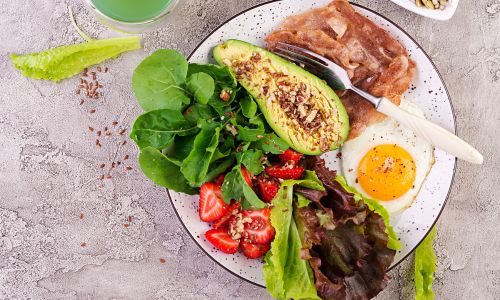The Ultimate Guide to Healthy Eating for Weight Loss
In “The Ultimate Guide to Healthy Eating for Weight Loss,” readers will discover valuable information and insights on achieving their weight loss goals through a balanced and nutritious diet. Packed with practical tips and expert advice, this guide dives into the principles of healthy eating, emphasizing the importance of incorporating whole foods, finding the right balance of macronutrients, and making sustainable lifestyle choices. Whether you’re a seasoned health enthusiast or just starting your weight loss journey, this comprehensive guide offers a wealth of guidance to help you make informed decisions about what you eat, while still enjoying delicious and satisfying meals.

Creating a Healthy Eating Plan
Contents
Understanding Macronutrients
In order to create a healthy eating plan for weight loss, it is essential to have a good understanding of macronutrients. Macronutrients are the nutrients that our bodies require in larger quantities, which include carbohydrates, proteins, and fats. Each macronutrient plays a vital role in our overall health and can affect our weight loss journey. By understanding how these macronutrients work in our bodies, we can make informed decisions when it comes to selecting the right foods to incorporate into our diet.
Balancing Calories and Portion Sizes
When it comes to weight loss, finding the right balance between calories and portion sizes is crucial. To create a healthy eating plan, it is important to be aware of the number of calories consumed and to ensure that portion sizes are appropriate. Consuming more calories than what our bodies need can lead to weight gain, while consuming fewer calories can contribute to weight loss. By balancing our calorie intake and paying attention to portion sizes, we can achieve our weight loss goals in a healthy and sustainable way.
Planning Meals and Snacks
One of the keys to successfully maintaining a healthy eating plan is to plan meals and snacks ahead of time. By doing so, we can avoid making impulsive decisions that may not align with our weight loss goals. Planning meals allows us to ensure that we have a balanced diet that includes all the necessary nutrients. Moreover, having healthy snacks readily available can prevent us from reaching for unhealthy options when hunger strikes. By taking the time to plan our meals and snacks, we set ourselves up for success on our weight loss journey.
Importance of Fruits and Vegetables
Increasing Fruit Intake
Fruits are an essential component of a healthy eating plan and can play a significant role in weight loss. They are not only packed with essential vitamins and minerals, but they also provide our bodies with dietary fiber, which aids in digestion and helps us feel fuller for longer. To increase fruit intake, it is recommended to incorporate a variety of fruits into our diet. Whether enjoyed as a snack, added to smoothies, or used as ingredients in recipes, the possibilities are endless when it comes to incorporating fruits into our daily meals.
Including More Vegetables in Your Diet
In addition to fruits, vegetables are equally essential when it comes to weight loss and overall health. Vegetables are low in calories but rich in essential nutrients, making them an ideal food choice for those looking to shed some pounds. To include more vegetables in your diet, try incorporating them into every meal. Whether it’s adding spinach to your breakfast omelet, enjoying a colorful salad for lunch, or roasting a medley of vegetables for dinner, there are countless ways to make veggies a delicious and nutritious part of your daily meals.
Exploring Different Varieties
When it comes to both fruits and vegetables, it’s important to explore different varieties. The world of fruits and vegetables is vast, and each variety offers its unique set of nutrients and flavors. By trying out different fruits and vegetables, we not only prevent ourselves from getting bored with our eating plan but also ensure that we are getting a diverse range of nutrients. So go ahead and be adventurous try exotic fruits, experiment with unfamiliar vegetables, and embrace the wide array of options nature has to offer.
The Power of Protein

Choosing Lean Protein Sources
Protein is an essential macronutrient that plays a crucial role in weight loss and overall health. When selecting protein sources, it is essential to choose lean options that are low in saturated fat. Some excellent choices for lean protein sources include skinless poultry, fish, beans, legumes, and tofu. These options provide a good amount of protein while minimizing the intake of unhealthy fats. By incorporating lean protein sources into our meals, we can feel satisfied for longer periods and support our weight loss goals.
Calculating Protein Needs
Understanding our protein needs is vital when it comes to creating a healthy eating plan. The amount of protein required varies depending on factors such as age, weight, and activity level. As a general guideline, it is recommended to consume about 0.8 grams of protein per kilogram of body weight. This means that a person who weighs 68 kilograms would need around 54 grams of protein per day. By calculating our protein needs and incorporating this macronutrient into our meals, we can promote muscle growth, aid in weight loss, and support overall health.
Incorporating Plant-based Proteins
For those following a vegetarian or vegan lifestyle, incorporating plant-based proteins is essential. Plant-based proteins, such as tofu, tempeh, lentils, and quinoa, can provide the necessary nutrients our bodies need to thrive. By including a variety of plant-based protein sources in our meals, we can ensure that we are meeting our protein requirements while nourishing our bodies with essential vitamins, minerals, and fiber. Whether it’s a hearty lentil soup, a flavorful tofu stir-fry, or a protein-packed quinoa salad, plant-based proteins offer a wide range of delicious possibilities for those looking to lose weight.
Healthy Fats for Weight Loss
Identifying Good and Bad Fats
Contrary to popular belief, not all fats are created equal. While certain fats, such as saturated and trans fats, contribute to weight gain and various health issues, others, such as mono- and polyunsaturated fats, are considered healthy and beneficial. To identify good fats, it is important to look for sources like avocados, nuts, seeds, and olive oil. These healthy fats can provide our bodies with essential fatty acids, support brain function, and promote heart health. On the other hand, bad fats found in fried foods, processed snacks, and high-fat dairy products should be limited to maintain a healthy weight.
Incorporating Healthy Fats in Your Diet
Incorporating healthy fats into our diet is a great way to support weight loss efforts. Adding a serving of avocado to a salad, drizzling olive oil on roasted vegetables, or enjoying a handful of nuts as a snack are simple ways to include healthy fats in our meals. By incorporating these fats into our diet, we can enhance the taste and satiety of our meals while reaping the numerous health benefits they provide.
Monitoring Fat Intake
While healthy fats are beneficial for weight loss, it is important to monitor our overall fat intake. Fats are calorie-dense, containing nine calories per gram, which is more than double the calories found in carbohydrates and protein. To ensure that our fat intake is within a healthy range, it is recommended to limit fat consumption to about 20-35% of our total daily calories. By being mindful of our fat intake and opting for healthy fats in moderation, we can support our weight loss goals and maintain a well-rounded and balanced eating plan.
Carbohydrates and Weight Loss
Differentiating Complex and Simple Carbohydrates
Carbohydrates are a crucial source of energy for our bodies, but not all carbohydrates are created equal. It is important to differentiate between complex and simple carbohydrates when creating a healthy eating plan for weight loss. Complex carbohydrates, such as whole grains, legumes, and vegetables, contain fiber and take longer to digest, providing a steady release of energy. On the other hand, simple carbohydrates, found in sugary treats and processed foods, are quickly digested, leading to spikes in blood sugar levels and potential weight gain. By focusing on consuming complex carbohydrates, we can support our weight loss efforts while nourishing our bodies.
Finding the Right Balance
Finding the right balance of carbohydrates is crucial for weight loss. While cutting out carbohydrates completely is not recommended, it is important to choose the right types and portion sizes. The American Dietary Guidelines suggest that carbohydrates should make up around 45-65% of our total daily calorie intake. By focusing on whole grains, vegetables, and legumes, we can incorporate carbohydrates into our meals while keeping our calorie intake in check. Balancing our carbohydrate intake is key to maintaining stable blood sugar levels, feeling full, and supporting overall weight loss.
The Role of Fiber in Weight Management
Fiber plays a significant role in weight management, and incorporating an adequate amount into our diet can be beneficial for weight loss. Foods rich in fiber, such as whole grains, fruits, vegetables, and legumes, offer numerous benefits. Fiber slows down digestion, helping us feel full for longer periods, which can prevent overeating. Additionally, fiber aids in digestion, promotes bowel regularity, and can help control blood sugar levels. By focusing on incorporating fiber-rich foods into our meals, we can support our weight loss goals and overall well-being.
Reducing Added Sugar Consumption
Reducing added sugar consumption is essential for weight loss and overall health. Added sugars, found in sugary drinks, processed snacks, and desserts, can contribute to weight gain and increase the risk of various health issues. By reducing our intake of added sugars, we can reduce calorie consumption and support weight loss efforts. Instead of reaching for sugary treats, opt for naturally sweet options like fresh fruits. If sweetness is desired, consider using healthier alternatives like stevia or honey in moderation.
Understanding Hidden Sugars
Hidden sugars can often sneak into our diet without us even realizing it. Many processed foods, including sauces, dressings, and even savory snacks, contain hidden sugars. To navigate hidden sugars, it is important to read food labels and become familiar with the various names for added sugars, such as sucrose, fructose, and corn syrup. By being mindful of hidden sugars and opting for whole, unprocessed foods as much as possible, we can reduce our sugar intake and make progress on our weight loss journey.
Managing Sodium Intake
While sodium is an essential nutrient, consuming too much can lead to water retention, bloating, and potentially hinder weight loss efforts. To manage sodium intake, it is important to be mindful of the amount of salt added to meals and to limit consumption of processed foods, which are often high in sodium. Instead of relying on salt for flavor, experiment with herbs, spices, and other seasonings to enhance taste without excess sodium. By reducing sodium intake, we can support healthy weight loss while maintaining overall health.
Smart Snacking Strategies
Choosing Nutrient-Dense Snacks
Snacking plays an important role in maintaining energy levels throughout the day and preventing overeating during meals. When selecting snacks, it is important to choose nutrient-dense options that provide essential vitamins and minerals without excessive calories. Examples of nutrient-dense snacks include fresh fruits, vegetables with hummus, Greek yogurt, and handfuls of nuts. By opting for these healthier options, we can satisfy hunger between meals while ensuring that we are nourishing our bodies with the nutrients they need.
Creating a Snack Plan
Creating a snack plan can help prevent impulsive snacking and ensure that we have healthy options readily available. By planning ahead, we can stock our pantry and refrigerator with fruits, vegetables, and other nutritious snacks, making it easier to make healthy choices. Preparing snacks ahead of time, such as cutting up fruits or portioning out nuts, can also save time and help manage portion sizes. By having a snack plan in place, we can avoid reaching for unhealthy options and stay on track with our weight loss goals.
Avoiding Mindless Snacking
Mindless snacking can often derail weight loss efforts without us even realizing it. To avoid mindless snacking, it is important to be mindful of our eating habits and recognize the difference between true hunger and emotional or boredom eating. Practice mindful eating by sitting down and focusing on the food being consumed, savoring each bite and paying attention to feelings of satisfaction. By being present and mindful during snack times, we can prevent mindless snacking and better support our weight loss journey.
Hydration and Weight Loss
Importance of Drinking Enough Water
Staying hydrated is essential for overall health and can also support weight loss efforts. Water not only helps maintain optimal bodily functions but can also help curb appetite and support digestion. By drinking enough water throughout the day, we can stay hydrated, feel more satisfied, and potentially consume fewer calories. Aim to drink at least eight cups (64 ounces) of water per day, and increase intake if engaging in physical activity or during hotter weather. Staying hydrated is a simple yet impactful strategy for promoting weight loss and overall well-being.
Alternative Hydration Options
While water is the best choice for hydration, there are alternative options for those looking to switch things up. Herbal tea, unsweetened iced tea, and infused water are excellent options that can provide additional flavors and nutrients without added calories. However, it is important to be mindful of the ingredients used in these alternatives and avoid sweeteners or syrups that can add unnecessary calories. By exploring alternative hydration options, we can stay on track with our weight loss goals while enjoying a variety of refreshing drinks.
Monitoring Fluid Intake
While staying hydrated is important, it is also essential to monitor fluid intake and avoid excessive consumption. Drinking excessive amounts of fluids may lead to water retention and can potentially disrupt electrolyte balance. It is recommended to drink fluids in moderation, paying attention to signals of thirst and the body’s hydration needs. Remember that hydration needs vary depending on factors such as activity level, climate, and individual differences. By monitoring fluid intake and finding the right balance, we can support our weight loss journey without compromising our health.
Eating Out and Weight Loss
Making Healthy Choices at Restaurants
Eating out at restaurants can pose challenges for individuals on a weight loss journey, but with the right strategies, it can be manageable. When dining out, it is important to prioritize healthy options by opting for salads, grilled lean proteins, and vegetable-based dishes. Ask for dressings and sauces on the side to control portion sizes, and be mindful of portion sizes provided by restaurants, which are often larger than necessary. Additionally, take your time to enjoy the meal, savoring each bite, and listening to your body’s signals of fullness. By making healthy choices and practicing mindful eating, dining out can still align with your weight loss goals.
Navigating Social Gatherings
Social gatherings, such as parties or family events, often involve food that can be tempting but not necessarily conducive to weight loss. To navigate these situations, plan ahead by eating a healthy snack or meal prior to the event to avoid arriving hungry. When faced with a buffet or table full of indulgent options, be selective and choose smaller portions of healthier alternatives. Focus on enjoying the company and conversation rather than fixating solely on the food. By being mindful and making intentional choices, we can successfully navigate social gatherings without derailing our weight loss progress.
Managing Portion Sizes
Portion sizes can significantly impact weight loss efforts, and managing them is essential both at home and when eating out. It is important to be aware of appropriate portion sizes and to recognize when we may be overeating. At home, using measuring cups or a food scale can help with portion control. When dining out, ask for a to-go box at the beginning of the meal and portion out a reasonable amount before eating. By managing portion sizes, we can ensure that we are consuming the appropriate amount of food to support our weight loss goals.
Building a Support System
Seeking Support from Loved Ones
Building a support system is essential for long-term success in a weight loss journey. One of the first places to seek support is from loved ones, such as family and close friends. Share your goals and challenges with them, and ask for their encouragement and understanding. Having a supportive network can provide the motivation and accountability needed to stay committed to healthy eating habits and weight loss goals.
Joining Weight Loss Communities
In addition to seeking support from loved ones, joining weight loss communities can provide an additional level of support and accountability. Online forums, social media groups, and local weight loss groups offer opportunities to connect with like-minded individuals who are on a similar journey. These communities provide a platform to share experiences, exchange ideas, and celebrate milestones. By joining weight loss communities, you can gain valuable insights, stay motivated, and feel a sense of camaraderie throughout your weight loss journey.
Working with a Registered Dietitian
For personalized guidance and support, working with a registered dietitian is highly recommended. A registered dietitian can create an individualized eating plan that aligns with your specific weight loss goals and dietary needs. They possess the knowledge and expertise to navigate through the different aspects of healthy eating, from macronutrients to portion control. By working with a registered dietitian, you can receive professional guidance, reassurance, and the tools necessary to create a healthy eating plan that promotes weight loss and sustains long-term success.
In conclusion, creating a healthy eating plan for weight loss requires a comprehensive understanding of macronutrients, a focus on nutrient-dense foods, and a mindful approach to eating. By incorporating fruits, vegetables, lean proteins, healthy fats, and appropriate carbohydrates into our meals, we can support our weight loss goals while nourishing our bodies. Additionally, strategies such as monitoring portion sizes, navigating sugary and salty foods, and practicing smart snacking can further enhance our weight loss success. Don’t forget the importance of staying hydrated, making healthy choices when dining out, and building a strong support system to help navigate the weight loss journey. With a well-rounded approach and a commitment to making sustainable lifestyle changes, achieving a healthy weight becomes attainable and enjoyable.






